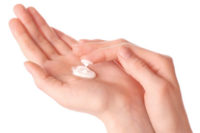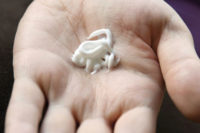
Here’s the skinny on worker skin safety: According to the National Institute for Occupational Safety & Health (NIOSH), one out of every four workers is exposed to some form of skin irritant in the workplace.
Whether it’s a maintenance worker, manufacturing worker, mechanic or food service worker, chances are good that they are dealing with some type of skin hazard. These hazards can cause numerous skin problems. The results can be anything from simple dry skin to more advanced, painful and costly problems such as dermatitis.
Educate your workers
Employees often think having cracked or dry skin is simply part of the job, not realizing cracked skin can lead to more severe problems because it allows harmful substances to more easily penetrate the skin’s outer layer.In order to prevent skin damage workers must be educated about the importance of maintaining healthy skin and how doing so can prevent doctor visits and lost work time. They need to know the potential hazards of the substances they work with and how those substances can affect their skin. Education on how to safely and effectively remove those substances from their hands during the workday and once their workday is complete is also critical.
A three-step program can help prevent skin irritation. This program should be specific to the substances being handled, and include:
- A before-work product
- A cleaner;
- An after-work skin conditioner.
Before work begins
A before-work cream can be used to help maintain the integrity of the outer skin layer. Before-work creams designed to be hazard-specific, with efficacy studies to confirm the results, are the key, rather than an all-purpose cream. Proper selection of the before-work cream is important. The cream should be matched to the specific work environment.Encouraging employees to apply a cream prior to work can be a challenge. The idea is to help maintain the integrity of the outer skin layer, called the stratum corneum, which is only three red blood cells thick. Without proper protection, the everyday use of common workplace chemicals, degreasers, solvents and just plain abrasion will take its toll.
Again, education is key. Potential skin irritants and sensitizers must be identified. Employees need training to better recognize them, and the precautions to take. Once identified, the appropriate before-work creams should be dispensed from a location easily accessible to employees. Small, portable sample sizes tend to get misplaced. A wall-mounted dispenser near the wash-up area or locker room is preferable.
Training in proper use of before-work creams is also very important. Make sure employees are instructed in proper application. The back of the hand is often missed when applying creams, but that skin is thinner than the skin of the palm, making it that much more important to cover well. Also, instruct employees to apply cream between the fingers, in the nail beds, and on the wrists and forearms as well. Forearm skin is particularly sensitive skin.
In addition, training posters, pamphlets, and video training help support the education of employees on the use of proper before-work skin creams.
Cleaners: what to avoid
The type of hand cleaner chosen is vitally important to skin health. Common cleaners such as paint thinner, abrasive powders and solvent or d’limonene-based hand cleaners should be avoided. The NIOSH Criteria Document on Organic Solvents finds that certain organic solvents such as xylene, found in common paint thinner, appears in the body within 15 minutes of skin contact.Borax and pumice-based abrasive hand cleaners strip away the skin’s natural barrier, the stratum corneum, making it more susceptible to rashes and dermatitis. Petroleum-based solvents may cause a defatting action on the skin, while d’limonene-containing hand cleaners may cause allergic, as well as dry skin conditions
When work day is done
Frequent skin contact with hazardous substances requires an effective after-work cream in order to help the skin heal and regenerate. Most people are familiar with the benefits of using a good skin moisturizer to replace lost moisture and oil, especially during the winter months when the lower humidity often results in additional moisture loss. In addition, the use of a harsh hand cleaner can aggravate the condition. Even the most skin-friendly hand cleaner can leave the skin dry with frequent use.Offer a moisturizing product formulated for workplace conditions. Most conditioning products sold at the retail level contain about 90 percent water. A product containing 15 percent to 30 percent fats or oils, dependant on degree of skin dryness, is preferable for working skin.
3,000 square inches
With the skin being the largest organ of the body, proper skin care is crucial to an individual’s health and safety. In fact, the skin comprises 3,000 square inches. This is a large surface area exposed to chemicals, physical irritants, mechanical stress and environmental factors. By using skin-compatible products in the correct manner, workers who suffer from skin irritation problems can see immediate results. An effective skin care program goes a long way in reducing your company’s risk, as well as improving safety and health for your workers.SIDEBAR - Dealing with dermatitis
If you think there may be a dermatitis problem among employees in your facility, here are some key issues that may help root out the cause of the problem:
- Are ventilation systems working properly?
- Have new chemicals, materials or processes been introduced to the workplace recently?
- Do employees know the importance of thoroughly washing any skin surface after contact with any dermatitis-causing agent?
- Is personal protective equipment (PPE) — impervious gloves, aprons, hoods — individually fitted and assigned to employees?
- Are barrier creams readily available and required before starting work?
- Are mild or lanolin-type soaps and soft hand towels provided in wash-up areas?
- Are employees prohibited from using solvents to clean oil and grease from skin surfaces?
- Are employees prohibited from washing machine parts in solvents with bare hands?
- Are employees who work with chemicals provided with a change of work uniforms or required to change work clothes daily?
- Are new hires screened for skin irritation problems in the pre-placement medical examination and assigned to work that will not further irritate the condition?
- Is personal hygiene stressed in training to correct dermatitis problems?
- Are solvent-soaked rags kept in separate drums or containers for removal by a cleaning service?
- Do supervisors understand the nature of the potential dermatitis problem in your facility?

